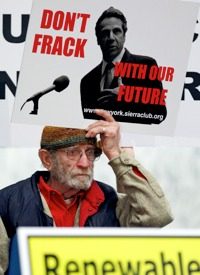
The Environmental Protection Agency (EPA) on Wednesday unveiled its first-ever regulations to curb air pollution from hydraulic fracturing, the drilling process commonly known as “fracking” — or in the industry’s parlance, “fracing.” By 2015, natural-gas and oil drillers will be forced to invest in new equipment that curtails smog-forming emissions from fracing wells.
The process of fracing involves a drilling technique that injects water, sand, and chemicals deep underground to crack shale rock formations and extract vast quantities of fuel, such as oil and natural gas. The new regulations — which also target air emissions from oil tanks, compressors, and other oil- and gas-related equipment — would purportedly slash 95 percent of toxic and smog-forming emissions from fracing wells.
“By ensuring the capture of gases that were previously released to pollute our air and threaten our climate, these updated standards will not only protect our health, but also lead to more product for fuel suppliers to bring to market,” EPA Administrator Lisa Jackson claimed in a statement. “They’re an important step toward tapping future energy supplies without exposing American families and children to dangerous health threats in the air they breathe.”
Specifically, the rules would cap emissions on volatile organic compounds (VOCs) — which emit smog when reacting with sunlight — as well as limit emissions of carcinogens and methane, a primary component of natural gas and an allegedly dominant contributor to climate change. Most air pollution emitted from gas sites emanates during the “well-completion phase,” which transpires after the well is drilled but before the gas is transmitted to pipelines and funneled to process plants, according to Robin Cooley, an attorney for the environmental group Earthjustice, which filed a lawsuit against the EPA to push the new standards.
Currently, during the fracing process drillers either let the methane escape, burn it, or capture and sell it as natural gas, a technique known as “green completion.” About half of those companies using the fracing method utilize green-completion technologies.
Industry leaders in the oil and natural-gas sectors voiced concerns that if the EPA enforced its regulations this year, there would be a severe shortage of green-completion technology — in turn, making it very expensive to comply.
The agency reviewed 150,000 industry comments on the proposed regulation and examined the availability of the new equipment, Gina McCarthy, the EPA’s assistant administrator on air and radiation, affirmed. In response, the EPA will permit companies to burn or flare their methane or use green-completion technology until the beginning of 2015. After that, all drillers who utilize the fracing method will be forced to capture their methane.
The EPA announced the new rule as the Obama administration attempts to propagate the idea that it supports the natural-gas industry, while maintaining an “environmentally-conscious” image — which, naturally, involves the use of regulatory force. Obama, for instance, used his State of the Union address to advocate for the natural-gas industry. However, at the same time the Interior Department is set to issue new regulations for fracing on public land, while the EPA conducts an in-depth analysis on the health effects of the method.
Natural-gas production has boomed in recent years, as the fracing process and other new techniques improved. Combined with advancements in horizontal drilling technology, fracing has spurred explosive growth in natural-gas production from shale, reported The Hill:
The federal Energy Information Administration estimates that shale gas will grow from 23 percent of U.S. gas production in 2010 to 49 percent in 2035. EIA, in a report earlier this year, projected that total U.S. gas production will rise from roughly 22 trillion cubic feet in 2010 to around 28 trillion cubic feet in 2035.
Critics have warned that new environmental rules could severely curtail the natural-gas boom, a boom that has brought down prices to 10-year lows. In response to such criticism, the President announced an executive order earlier this month to form a fracing oversight group that directs a dozen federal agencies to collaborate in bolstering “safe and responsible unconventional domestic natural gas development.”
“By helping to power our transportation system, greater use of natural gas can also reduce our dependence on foreign oil. And with appropriate safeguards, natural gas can provide a cleaner source of energy than other fossil fuels,” the President’s order stated. “It is vital that we take full advantage of our natural gas resources, while giving American families and communities confidence that natural gas and cultural resources, air and water quality, and public health and safety will not be compromised.”
However, the Obama administration has already used the excuse of controlling global-warming emissions to devastate the U.S. coal industry and coal-generated electric power — which if left unchecked will cause spikes in electric bills across the country — and it stands to reason that for the same reasons his administration will destroy the natural-gas industry in this country.
“EPA’s latest oil and gas regulations are a continuation of President Obama’s attack on hydraulic fracturing,” charged Sen. James Inhofe (R-Okla.), a global-warming skeptic and top GOP leader on the Senate Committee on Environment and Public Works. “President Obama has crafted a very clever election strategy: he’s going around the country touting the virtues of natural gas, while at the same time, he’s completely undermining natural gas development by working aggressively to shut down hydraulic fracturing — and these new air rules are very much a part of that agenda.”
The unveiling of these new EPA regulations, Inhofe averred, is just another step in the President’s “war on natural gas production.”
Photo: AP Images



